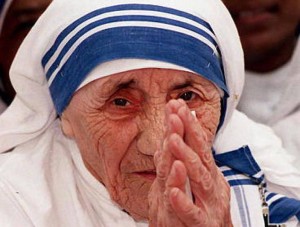
By editor - 08 March, 2016

Pope Francis will hold an ordinary public consistory of cardinals in the Vatican on 15 March, during which he will sign the decree for the canonisation of Blessed Mother Teresa of Kolkata.
The date and venue of her sainthood ceremony are expected to be declared at the consistory.
Pope Francis officially cleared Blessed Mother Teresa for sainthood on 17 December 2015, recognising the miraculous healing through her intercession of a Brazilian man with multiple brain abscesses.
Mother Teresa was beatified in Rome in 2003, after Pope St John Paul II recognised the miraculous healing of an Indian woman with a tumour in her abdomen.
Born Agnes Gonxha Bojaxhiu of Albanian parents on 26 August 1910 in Skopje, in what is Macedonia today, Mother Teresa died in Kolkata, formerly Calcutta, on 5 September 1997.
Affectionately known as the ‘saint of the gutter’ for her unconditional love for the poor, abandoned and the marginalised, she earned several international honours, including the Nobel Peace Prize in 1979.
Last December, the Primate of All Ireland, Archbishop Eamon Martin, welcoming the news that a second miracle had been attributed to Blessed Teresa’s intercession, clearing the way for her canonisation, she is much loved in Ireland and was a frequent visitor to the country.
“At the age of 18, Blessed Teresa came here to study English and begin her life as a nun with the Loreto Sisters in Dublin,” the Archbishop said.
“In this Year of Mercy, I am conscious of a convent of Missionaries of Charity in Armagh and indeed Missionaries of Charity in several other Irish dioceses.”
He added that the news “reminds us of the life of mercy that Blessed Mother Teresa lived as one who was ‘merciful as our heavenly Father is merciful’.”
At the time of her death, the foundress of the Missionaries of Charity had nearly 4,500 Sisters and Brothers ministering all over the world in hospices for the dying destitute, orphanages, homeless shelters and clinics for those with HIV/AIDS and leprosy.
Mother Teresa, born in Macedonia as Agnes Gonxha Bojaxhiu in 1910, was beatified in 2003 in Rome after the Vatican said an Indian woman’s prayers to the nun rid her of an incurable tumour.
She left her home in 1928 at the age of 18 to join the Loreto Sisters at Loreto Abbey Rathfarnham in Dublin where she was to learn English with a view to becoming a missionary in India.
She arrived in India in 1929, and began her novitiate in Darjeeling, in the Himalayan mountains, where she learnt Bengali and taught at St Teresa’s School, a schoolhouse close to her convent.
She took her first religious vows as a nun on 24 May 1931. At that time she chose to be named after Thérèse de Lisieux, the patron saint of missionaries, but because one nun in the convent had already chosen that name, Agnes opted for the Spanish spelling of Teresa.
She took her solemn vows on 14 May 1937, while serving as a teacher at the Loreto convent school in Entally, eastern Kolkata.
Mother Teresa served there for almost twenty years and in 1944 was appointed headmistress.
Although she enjoyed teaching at the school, she was increasingly disturbed by the poverty surrounding her in Kolkata.
The Bengal famine of 1943 brought misery and death to the city; and the outbreak of Hindu/Muslim violence in August 1946 plunged the city into despair and horror.
On 10 September 1946, Teresa experienced what she later described as “the call within the call” while travelling by train to the Loreto convent in Darjeeling from Kolkata for her annual retreat.
“I was to leave the convent and help the poor while living among them. It was an order. To fail would have been to break the faith.”
One author later observed, “Though no one knew it at the time, Sister Teresa had just become Mother Teresa.”
She began her missionary work with the poor in 1948, replacing her traditional Loreto habit with a simple white cotton sari decorated with a blue border.
Mother Teresa adopted Indian citizenship, spent a few months in Patna to receive a basic medical training in the Holy Family Hospital and then ventured out into the slums.
Initially, she started a school in Motijhil (Kolkata); soon she started tending to the needs of the destitute and starving.
In the beginning of 1949, she was joined in her effort by a group of young women, a number of whom were former students of her at Loreto, and these laid the foundations of a new religious community helping the “poorest among the poor”.
Pope Francis is known to be a fan of Mother Teresa’s. During a September 2014 visit to Albania, he told his interpreter that he was not only impressed by her fortitude, but in some ways feared it.
He recounted that he had met Mother Teresa when they both attended a 1994 bishops’ synod at the Vatican.
According to Vatican spokesman, Fr Federico Lombardi, the then Archbishop Bergoglio had Mother Teresa behind him and “he heard her intervene often with great strength, without letting herself in any way be intimidated by this assembly of bishops.”
“And from that he developed a great esteem for her, as a strong woman, a woman able to give courageous testimony.”